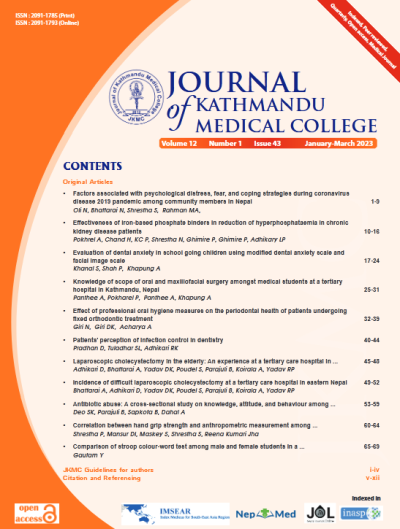Effectiveness of iron-based phosphate binders in reduction of hyperphosphataemia in chronic kidney disease patients
DOI:
https://doi.org/10.3126/jkmc.v12i1.56687Keywords:
Chronic renal insufficiency, Ferric citrate, Hyperphosphataemia, Iron-deficiency anaemiaAbstract
Background: Ferric citrate is novel iron-based phosphate-binding drug for management of hyperphosphataemia and iron-deficiency anaemia in chronic kidney disease (CKD) patients.
Objectives: To evaluate impact of ferric citrate therapy on reduction of phosphate levels and improvement in haematological parameters in CKD stages 3-5.
Methods: This analytical, observational study was conducted at Kathmandu Medical College Teaching Hospital from 2020 July-December after ethical clearance using convenience sampling method. Non-dialysis dependent patients at CKD stages 3-5, having hyperphosphataemia (serum phosphate >=4.6mg/dL) and anaemia (serum haemoglobin <12 gm%, transferrin saturation <=30%, ferritin <=300ng/mL) were administered with 2gm twice daily dose of ferric citrate for 12 weeks and evaluated on outcomes in terms of reduction in serum phosphate levels and improvement in haematological parameters as study endpoints. Data were entered in Microsoft Excel and analysed in SPSS v.25. Significance level was set at p <0.05.
Results: Of 84 study participants, majority had CKD stage 4 (46, 54.76%). A significant reduction (p <0.001) in mean serum phosphate levels of 6.21 ± 1.062 mg/dL from baseline to 4.89 ± 1.100 mg/dL in 12-weeks was observed. Patients with CKD stages 3, 4, and 5 had mean reduction of 1.67 (p = 0.005), 1.40 (p <0.001), and 1.04 mg/dL (p = 0.002) of serum Phosphate level respectively. Significant (p <0.001) improvements in hemoglobin level, serum iron, ferritin, total iron binding capacity, and transferrin saturation were reported.
Conclusion: Ferric citrate is effective and well-tolerated phosphate-binder to improve hyperphosphataemia and iron deficiency anaemia in non-dialysis CKD stage 3, 4, and 5.
Downloads
Downloads
Published
How to Cite
Issue
Section
License

This work is licensed under a Creative Commons Attribution-NonCommercial 4.0 International License.
Copyright © Journal of Kathmandu Medical College
The ideas and opinions expressed by authors or articles summarized, quoted, or published in full text in this journal represent only the opinions of the authors and do not necessarily reflect the official policy of Journal of Kathmandu Medical College or the institute with which the author(s) is/are affiliated, unless so specified.
Authors convey all copyright ownership, including any and all rights incidental thereto, exclusively to JKMC, in the event that such work is published by JKMC. JKMC shall own the work, including 1) copyright; 2) the right to grant permission to republish the article in whole or in part, with or without fee; 3) the right to produce preprints or reprints and translate into languages other than English for sale or free distribution; and 4) the right to republish the work in a collection of articles in any other mechanical or electronic format.




